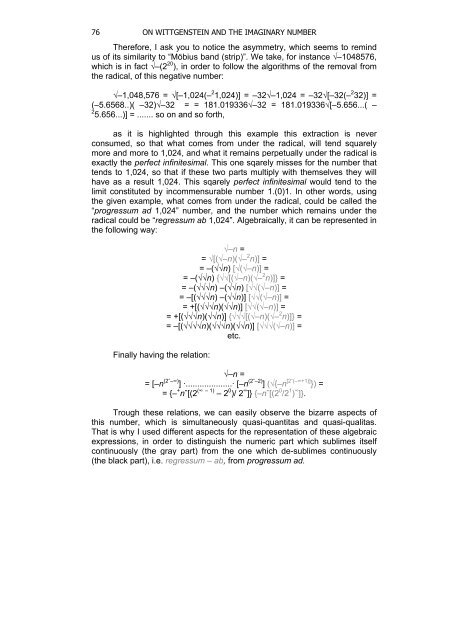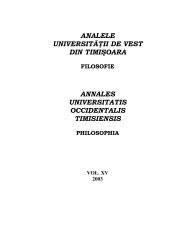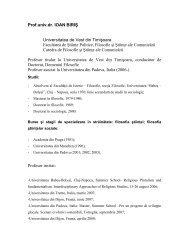VOL. IV (XXI) 2009 - Departamentul de Filosofie si Stiinte ale ...
VOL. IV (XXI) 2009 - Departamentul de Filosofie si Stiinte ale ...
VOL. IV (XXI) 2009 - Departamentul de Filosofie si Stiinte ale ...
Create successful ePaper yourself
Turn your PDF publications into a flip-book with our unique Google optimized e-Paper software.
76 ON WITTGENSTEIN AND THE IMAGINARY NUMBER<br />
Therefore, I ask you to notice the asymmetry, which seems to remind<br />
us of its <strong>si</strong>milarity to “Möbius band (strip)”. We take, for instance √–1048576,<br />
which is in fact √–(2 20 ), in or<strong>de</strong>r to follow the algorithms of the removal from<br />
the radical, of this negative number:<br />
√–1,048,576 = √[–1,024(– 2 1,024)] = –32√–1,024 = –32√[–32(– 2 32)] =<br />
(–5.6568..)( –32)√–32 = = 181.019336√–32 = 181.019336√[–5.656...( –<br />
2 5.656...)] = ....... so on and so forth,<br />
as it is highlighted through this example this extraction is never<br />
consumed, so that what comes from un<strong>de</strong>r the radical, will tend squarely<br />
more and more to 1,024, and what it remains perpetually un<strong>de</strong>r the radical is<br />
exactly the perfect infinite<strong>si</strong>mal. This one sqarely misses for the number that<br />
tends to 1,024, so that if these two parts multiply with themselves they will<br />
have as a result 1,024. This sqarely perfect infinite<strong>si</strong>mal would tend to the<br />
limit constituted by incommensurable number 1.(0)1. In other words, u<strong>si</strong>ng<br />
the given example, what comes from un<strong>de</strong>r the radical, could be called the<br />
“progressum ad 1,024” number, and the number which remains un<strong>de</strong>r the<br />
radical could be “regressum ab 1,024”. Algebraically, it can be represented in<br />
the following way:<br />
Finally having the relation:<br />
√–n =<br />
= √[(√–n)(√– 2 n)] =<br />
= –(√√n) [√(√–n)] =<br />
= –(√√n) {√√[(√–n)(√– 2 n)]} =<br />
= –(√√√n) –(√√n) [√√(√–n)] =<br />
= –[(√√√n) –(√√n)] [√√(√–n)] =<br />
= +[(√√√n)(√√n)] [√√(√–n)] =<br />
= +[(√√√n)(√√n)] {√√√[(√–n)(√– 2 n)]} =<br />
= –[(√√√√n)(√√√n)(√√n)] [√√√(√–n)] =<br />
etc.<br />
√–n =<br />
= [–n (2ˆ–∞) ] ·....................· [–n (2ˆ–2) ] (√{–n [2ˆ(–∞+1)] }) =<br />
= {– + nˆ[(2 (∞ – 1) – 2 0 )/ 2 ∞ ]} {–nˆ[(2 0 /2 1 ) ∞ ]}.<br />
Trough these relations, we can ea<strong>si</strong>ly observe the bizarre aspects of<br />
this number, which is <strong>si</strong>multaneously qua<strong>si</strong>-quantitas and qua<strong>si</strong>-qualitas.<br />
That is why I used different aspects for the representation of these algebraic<br />
expres<strong>si</strong>ons, in or<strong>de</strong>r to distinguish the numeric part which sublimes itself<br />
continuously (the gray part) from the one which <strong>de</strong>-sublimes continuously<br />
(the black part), i.e. regressum – ab, from progressum ad.




